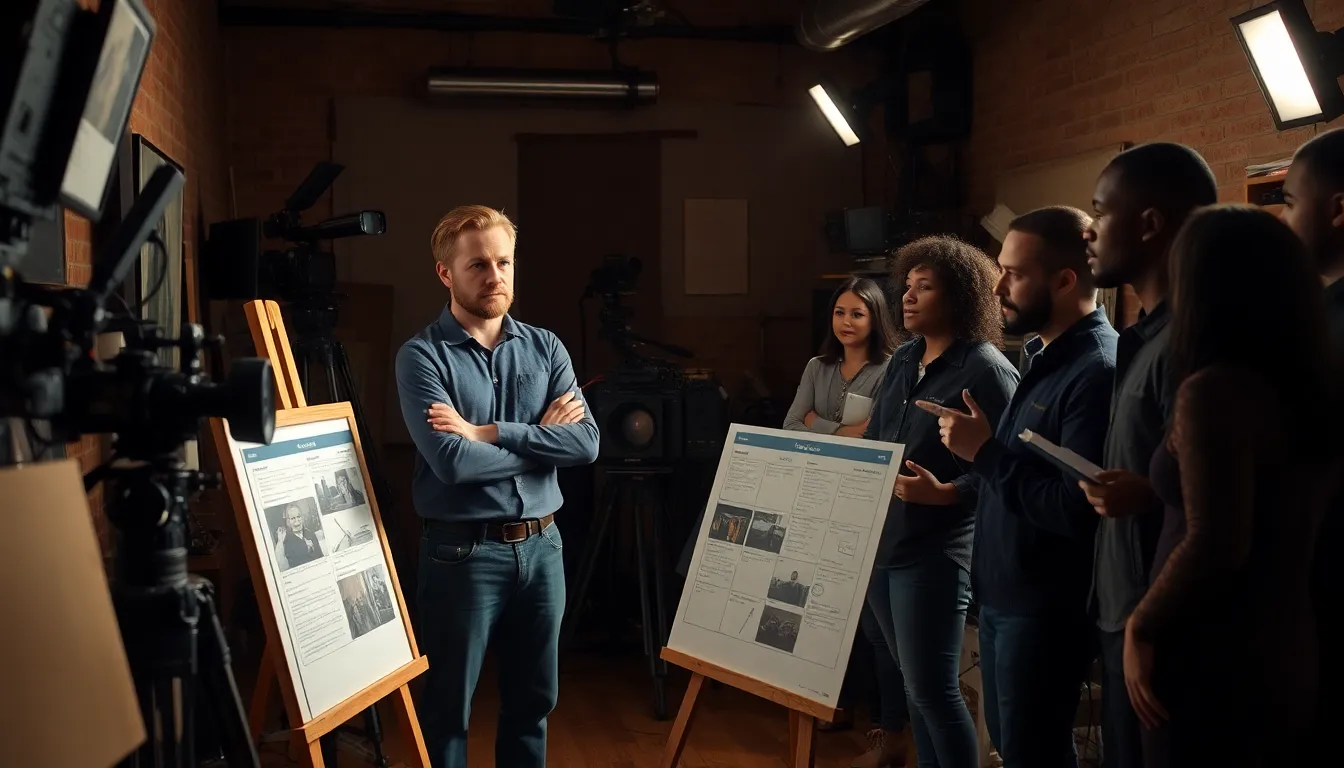Genre film analysis offers a fascinating lens through which to explore the intricacies of storytelling in cinema. By categorizing films into distinct genres, viewers can uncover the unique conventions and tropes that shape narratives, character development, and audience expectations. This method not only enhances appreciation for individual films but also reveals broader cultural themes and societal reflections embedded within the genre.
As filmmakers continue to innovate within these established frameworks, genre analysis becomes essential for understanding the evolution of cinema. Whether it’s the chilling suspense of horror or the heartwarming arcs of romantic comedies, each genre serves as a canvas for creativity. By delving into the elements that define these categories, audiences can gain deeper insights into the artistic choices that resonate across time and culture.
Table of Contents
ToggleUnderstanding Genre Film Analysis
Genre film analysis examines the components and conventions of film genres, enabling insights into storytelling and cultural contexts. This analysis plays a critical role in appreciating both specific films and the industry as a whole.
Definition and Importance
Genre film analysis involves categorizing films based on shared characteristics, including themes, plots, and visual styles. This classification aids viewers in recognizing the patterns and tropes associated with various genres, such as action, horror, or comedy. Understanding genres enhances audience expectations, as it allows them to anticipate narrative structures and emotional responses. Moreover, analyzing genres contributes to a deeper understanding of cultural reflections, showcasing how films capture societal moods, values, and issues.
Historical Context
Genre film analysis has roots in the early days of cinema, where silent films established foundational genres like westerns and comedies. The introduction of sound in the late 1920s led to more defined genre conventions, influencing filmmakers and audiences alike. Over time, genres evolved, incorporating subgenres that further diversified cinematic expression. The 1970s marked a pivotal era with the rise of genre experimentation, as filmmakers challenged existing norms and blended elements from different genres. This historical progression reveals how genres influence and are influenced by technological advances, audience tastes, and cultural shifts, forming a dynamic landscape in the film industry.
Key Elements of Genre

Understanding the key elements of genre enhances the appreciation of film and its storytelling techniques. Two critical aspects include themes and motifs, along with stylistic features.
Themes and Motifs
Themes and motifs serve as foundational components in genre films. Genres often revolve around specific themes, such as love in romantic comedies or survival in horror films. Recurring motifs enhance the narrative depth, providing visual or auditory symbols that resonate with audiences. For example, the motif of darkness commonly appears in horror, reflecting themes of fear and the unknown. Recognizing these elements allows viewers to anticipate plot developments and connect with the underlying messages of the film.
Stylistic Features
Stylistic features encompass visual and auditory elements that define a genre’s unique identity. Cinematic techniques, such as lighting, color palettes, and camera angles, play pivotal roles in constructing the mood and tone. For instance, bright colors and upbeat music characterize comedy, while darker tones and suspenseful scores are prevalent in thrillers. Editing styles, like rapid cuts or long takes, further shape the viewing experience, influencing audience emotions and engagement. Analyzing these features helps reveal how filmmakers adhere to or subvert genre conventions to create innovative narratives.
Types of Film Genres
Film genres can be broadly categorized into narrative and non-narrative types. Each category encompasses distinct characteristics that shape how stories are told on screen.
Narrative Genres
Narrative genres focus on storytelling through structured plots, character arcs, and themes. Common examples include:
- Drama: Emphasizes emotional conflicts and character development, often exploring serious themes.
- Comedy: Aims to entertain and provoke laughter through humor, often highlighting social situations or misunderstandings.
- Action: Features dynamic sequences, physical challenges, and high-stakes scenarios, often centered on a hero’s journey.
- Thriller: Builds suspense and excitement through tension-filled scenarios, often with twists and psychological elements.
- Fantasy: Introduces imaginative worlds and supernatural elements, allowing for exploration of limitless possibilities.
- Science Fiction (Sci-Fi): Explores futuristic concepts, technology, and alternate realities, often prompting philosophical questions.
- Horror: Instills fear and dread, utilizing horror icons, tropes, and psychological elements to engage audiences.
Each narrative genre possesses unique conventions that enhance viewer engagement and reflection on societal themes.
Non-Narrative Genres
Non-narrative genres focus on thematic expression rather than traditional storytelling. Key examples include:
- Documentary: Presents factual content, often incorporating interviews, historical footage, and observational techniques to inform or educate.
- Experimental: Challenges conventional filmmaking techniques, often prioritizing artistic expression, aesthetics, and sensory experiences over narrative.
- Animated: Explores storytelling through animated techniques, ranging from traditional hand-drawn to computer-generated imagery, appealing to all ages.
- Musical: Combines song and dance elements, often conveying narratives through performance while highlighting emotional experiences.
Non-narrative genres encourage alternative viewer experiences, promoting diverse artistic approaches and broadening the understanding of cinematic expression.
Analyzing Audience Reception
Analyzing audience reception provides significant insights into how viewers engage with genre films. Audience reactions often reflect cultural values and preferences that shape the film industry.
Cultural Impact
Cultural impact highlights how genre films resonate with societal norms and issues. Films in genres like horror often tackle themes of fear and morality, reflecting societal anxieties. For instance, the rise of horror films during economic downturns illustrates how audience fears manifest on screen. Romantic comedies frequently explore themes of love and relationships, mirroring evolving cultural attitudes toward romance. The reception of these films can influence social discussions, leading to shifts in cultural narratives and perceptions.
Box Office Performance
Box office performance serves as a measurable metric for audience reception. Specific genres often perform better during particular timeframes, such as horror films during Halloween or romance films around Valentine’s Day. Statistics indicate that action and superhero genres typically dominate box office charts, accounting for over 50% of total box office revenue in recent years. Audiences frequently gravitate towards familiar genre conventions, driving financial success and influencing future film productions. Analyzing box office trends reveals how audience preferences shape the landscape of genre filmmaking and its commercial viability.
Case Studies in Genre Film Analysis
Genre film analysis encompasses an examination of both classic and contemporary films, revealing how specific themes, structures, and stylistic elements characterize various genres. These case studies highlight the evolution and impact of genre filmmaking throughout cinematic history.
Classic Genre Films
Classic genre films serve as foundational examples that illustrate the conventions and tropes established within their respective genres. Films like Casablanca (1942) define romantic drama through its themes of love, sacrifice, and moral ambiguity. The film’s narrative arc, centered around personal relationships set against a backdrop of war, exemplifies the emotional depth expected in classic romances. Similarly, Psycho (1960) revolutionizes the horror genre, utilizing suspenseful storytelling, innovative editing techniques, and psychological themes that challenge audience expectations.
Additionally, westerns such as The Good, the Bad and the Ugly (1966) exemplify the genre’s focus on law, morality, and rugged individualism. The use of expansive landscapes and archetypal characters further solidifies the genre’s identity. Such films establish benchmarks for narrative structure and character development that resonate across generations, showcasing how genre frameworks adapt and influence future cinematic works.
Contemporary Genre Films
Contemporary genre films demonstrate how filmmakers innovate within existing frameworks while reflecting modern cultural sensibilities. Get Out (2017) merges social commentary with horror, highlighting themes of racism and societal paranoia through a suspenseful narrative. This blending of genres challenges traditional horror conventions and invites deeper audience engagement with societal issues.
In the realm of romantic comedies, Crazy Rich Asians (2018) revitalizes the genre by centering on Asian characters and cultures, showcasing the importance of representation in storytelling. The film employs familiar tropes, such as class conflict and familial expectations, while refreshing the genre’s narrative approaches.
Furthermore, superhero films like Black Panther (2018) not only dominate box office revenue but also incorporate themes of identity and representation. The film’s cultural significance lies in its portrayal of African heritage and its exploration of power dynamics within a fictional society.
These contemporary examples illustrate that genre film analysis reveals advancements in narrative techniques and thematic depth, reflecting ongoing cultural dialogues while shaping audience perceptions.
Genre film analysis serves as a vital lens through which audiences can engage with cinema. By categorizing films based on shared characteristics, it reveals the intricate relationship between storytelling and cultural context. This approach not only deepens appreciation for individual films but also highlights the evolution of genres and their impact on societal narratives.
Through the examination of themes, motifs, and stylistic elements, genre analysis uncovers how filmmakers innovate within established frameworks. It reflects audience preferences and cultural values, showcasing the dynamic nature of the film industry. Ultimately, understanding genre allows viewers to appreciate the artistry behind filmmaking and its role in shaping cultural conversations.





